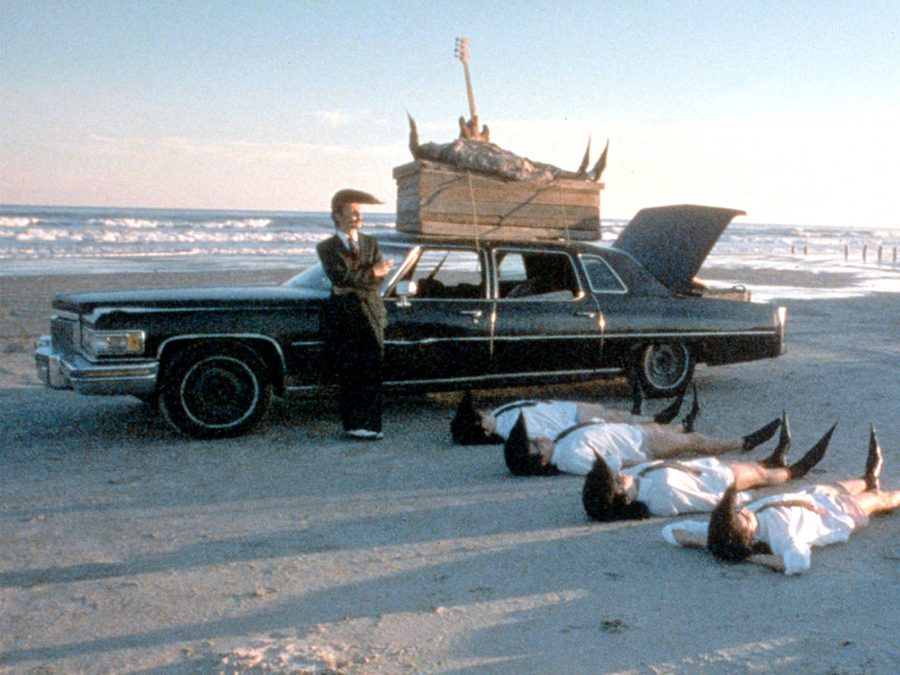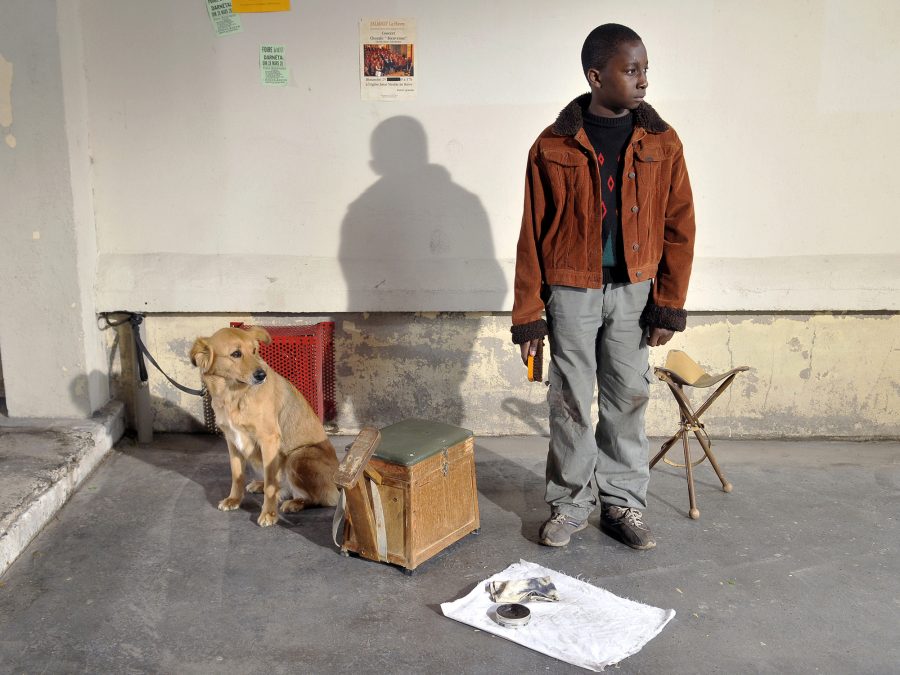My first encounter with the work of Aki Kaurismäki was on an awkward date. Which, if you’ve seen any of the filmmaker’s work, is very on brand. It was a press screening of his typically doleful 2006 comic feature, Lights in the Dusk, in which a hangdog night watchman with no friends hooks up with a gang of criminals in a bar purely for the company. The film’s gracefully lethargic plot, deader-than-deadpan humour, its strident critique of capitalism and the sudden bursts of classic rock’n’roll music made me feel like I was in the company of an old hand – someone more-than-worthy of further exploration. I’ll admit, we both were a tad bemused at the fact we were dropped so suddenly into Kaurismäki’s singular world without a road map, so for those planning to head out to see his scintillating, award-winning new work, Fallen Leaves, here are some bits and bobs to look out for.
It’s immediately apparent from seeing his brilliant new film, Fallen Leaves, that there’s no-one in the world of cinema quite like Aki Kaurismäki. He’s an armchair rebel from Finland who tells stories about beautiful losers, hard-drinking miscreants, and working class heroes not so much striving for wealth and comfort, but just to do whatever it takes to maintain the cosy status quo. For every moment of piquant, finely-judged humour, there’s a corresponding moment of aching tragedy, and life according to Kaurismäki – as so perfectly encapsulated in Fallen Leaves – is a slow merry-go-round gloom and bliss. The story, about an alcoholic labourer and an odd-jobbing loner trying to work out if falling in love would be a wise option in such a commercial climate, is delivered in classic Kaurismäki style, from the perfectly-judged deadpan performances, the crepuscular Helsinki landscapes, and the showcase of various local bar bands. But to endear you to his wonderful world, here are some other stylistic and thematic touchpoints coined over his incredible, one-of-a-kind oeuvre.
1. Timo
Director-cinematographer partnerships don’t come tighter than the one between Aki Kaurismäki and Timo Salminen. He has shot every one of the director’s films, starting with the 1981’s doc on the Finnish local music scene, The Saimaa Gesture. The Salminen touch is both highly distinctive and hard to define; his compositions are simple, uncluttered, subtly expressive, and are imbued with the melancholy lyricism of the painter Edward Hopper. The power of Salminen’s contributions to the Kaurismäki project is emphasised by the fact that, even when a story takes place outside Helsinki, maybe in London or Paris, the foreign locales still have that same, unmistakable dusky hue.
2. Teal
We may be diving in early on this one, but it cannot be emphasised enough how much Kaurismäki loves the colour teal. Houses, offices, bedrooms, walls, gates all happened to be doused in the blue-green shade that symbolises the cold, hard-wearing aesthetic of postwar architecture. It’s a colour you’d most often see in administration buildings as a practical solution to retain cleanliness, but Kaurismäki uses it not so much as a mood enhancer, but as an ironic mood suppressant. It also works beautifully in concert with Timo Salminen’s cinematography, especially when you have it as a background contrast for human faces in the foreground.
3. Local bands
The local music scene is a vital part of the Kaurismäki ecosphere, and while the majority of his films contain rowdy live music performances (often by obscure, ageing Finnish bar bands in powder blue tuxedos), he also made three (very funny) features and numerous shorts dedicated to the apocryphal Russian folk-rock outfit, The Leningrad Cowboys. One thread that runs through his selection of music acts is the ever-expanding influence of Americana on traditional musical styles, and 1989’s Leningrad Cowboys Go America, sees the band, with their insane pompadour hairstyles, tour the American South and adapt their playlist to the venue and clientele.

4. Matti and Kati
There are a number of regulars on the typical Kaurismäki call sheet, but there are two that stand out as his most iconic performers – whose look and acting style embody the director’s tragicomic mode. The first is the late, very great Matti Pellonpää, who graduated from smaller roles in early features Crime and Punishment (1983) and Calamari Union (1985) to play the lead in the gorgeous paean to an abrasive dustman looking for love, Shadows in Paradise (1986). Pellonpää is characterised by his bushy tash, plump jowls and thin, oily, slicked hair, and he stands as the ideal avatar for Kaurismäki’s gruffly sentimental worldview. We also have the sad-eyed Kati Outinen, who has a face that instantly makes you want to break down and weep. She first appeared as the female lead in Shadows in Paradise, but her greatest role is in the 1990 masterpiece, The Match Factory Girl, a Bressionian dark comedy about a woman who is oppressed and abused so relentlessly that – like a match – she finally breaks.
5. Booze
It’s often the case that the men in Kaurismäki films just cannot stop drinking. 1994’s screwball road movie Take Care of Your Scarf, Tatiana features two characters who literally cannot stop drinking: one, mini bottles of noxious clear alcohol; the other, coffee which he brews via a portable device attached to his car. While Kaurismäki has a certain fondness for the hangdog wino for whom the acquisition of booze is central to existence, he’s also unequivocal in his belief that, on the majority of occasions, imbibing to excess leads us to do regrettable things. Fallen Leaves is largely about one character’s fight against the demon drink and how it might tarnish his macho credo. On the other hand, in 1990’s London-set I Hired a Contract Killer, Jean-Pierre Leaud’s introverted office drone acquires a taste for liquor when he pays an assassin to kill him and realises he wants to live.
6. Movies
There’s a fair amount of cinemagoing in the films of Kaurismäki, and it’s usually the go-to venue for an awkward date. The director will often have fun with the posters and lobby cards that appear at the cinema, often for obscure world cinema classics that are part of his own foundational viewing. One utterly heartbreaking scene features in The Match Factory Girl, in which Kati Outinen’s character sits alone in a cinema bawling inconsolably while a Marx brothers film plays – one of cinema’s great depictions of utter despair. Yet the best cinema trip sequence can be seen in his new film, Fallen Leaves, where the prospective couple head on a chemistry-testing date and opt for a truly bizarre choice of film. And once they exit, we’re allowed to eavesdrop on a conversation between two fellow patrons and their hilariously misguided assessment of what they’ve just seen.
7. Cameos
Kaurismäki’s films are littered with cinephile references, whether in the production design or the dialogue. But the director is always looking for ways to shoehorn in the people he admires for background roles. Samuel Fuller crops up in 1992’s La Vie de bohème as a cantankerous Parisian magazine publisher, while Louis Malle features in the same film to pick up the restaurant bill of a character who’s had his wallet stolen. The French comedy director Piette Etaix turns up in 2011’s Le Havre as a doctor at the local hospital, and there’s also a moving cameo from French mid-century icon, Serge Regianni in I Hired a Contract Killer – there are deep cinephile subtexts to the fact that he saves the bacon of compatriot Jean-Pierre Leaud by allowing him to hide out as a fry chef in his greasy spoon café. Kaurismäki himself even cameos as a Chaplin impersonator in 1994’s Leningrad Cowboys Meet Moses.

8. The News
Filmmakers often use TV and radio as a quick shorthand for plot exposition, but Kaurismäki uses them to boldly anchor his fantasy-flecked comedies into the grimness of geopolitical reality. The Other Side of Hope from 2017 is the filmmaker’s response to Finland’s regressive response to the “migrant crisis”, while the radio supplies a running commentary on the conflict in Ukraine in Fallen Leaves. The films he’s made in the 21st century certainly skew towards a tradition of neorealism, where questions of social consciousness and the cruel mechanisms of political power come into play.
9. Classic cars
In Kaurismäki’s Helsinki, everyone has a fin-tailed vintage American luxury auto in their carport. In 1988’s moving miniature crime saga, Ariel, about an unemployed mine worker’s search for work and romance, a disgruntled father (feeling like the whole world has turned to shit) leaves an ice-white Cadilac convertible to his son before committing suicide in the restroom of a divebar. There’s a real sense that Kaurismäki pays a lot of care and attention to the cars in his films: some memorable ones include the three-wheel Robin Reliant used by the trio of artsy layabouts in La Vie de bohème; and the black stretch Cadillac sold to the Leningrad Cowboys by none other than a surprisingly loquacious Jim Jarmusch.
10. Dog Days
Aki Kaurismäki tends to premier his films at the Cannes Film Festival, and that only means one thing: he’s also in contention for the coveted Palm Dog award, given to the best dog performance in the festival. If there were ever a lifetime achievement Palm Dog, then Aki would be a shoo-in. Tähti won 2002 for for his performance as Hannibal in The Man Without a Past, comes from a long lineage of mutt movie stars – her mother and grandmother performed in earlier Kaurismäki films. And he loves dogs so much, he even opened a dog-friendly cinema in the Helsinki suburb of Karkkila called Cine-Laika, named after the famous Russian dog that was sent into space, but also the dog who starred in the 2011 film (playing himself!), La Havre.
Fallen Leaves is released in UK cinemas on 1 December Find screenings and book tickets at mubi.com/fallenleaves‘
The post The strange and beautiful world of Aki Kaurismäki appeared first on Little White Lies.
from Little White Lies https://ift.tt/U0AXJCx
via IFTTT

0 Comments